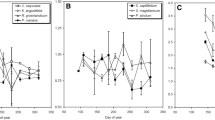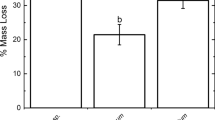Abstract
In a context of climate change peatlands may switch from a sink to a source of carbon (C). The induced positive feedbacks are closely linked to C dynamics, and thus to the fate of organic matter (OM) in the underlying peat. Our aims were to determine how moisture conditions in a Sphagnum-dominated peatland affect the dynamics of diagenetic sensitive OM which is thought to be the most reactive to warming effects. The approach was based on the identification of combined bulk and molecular bioindicators of OM sources and decay of peat profiles (up to 50 cm in depth) from two moisture conditions of the Le Forbonnet peatland (Jura Mountains, France). The (xylose + arabinose)/(galactose + rhamnose + mannose) ratio derived from the analysis of neutral monosaccharides was used to obtain indications on the botanical origin of the peat and tended to indicate a greater contribution of Cyperaceae in the deepest parts of the peat. Most bioindicators showed that OM decay increased with depth and was higher in the driest conditions. In these conditions, decay was shown by a loss of diagenetic sensitive oxygen-rich OM, probably leached by water table fluctuations. Decay intensity was also shown by the high ribose and lyxose contents at the peat surface, where microscopic observations also revealed relatively large quantities of fungal hyphae. The sugars could have arisen from microbial synthesis, primarily protozoan and fungal activity. These results suggest that water level changes preferentially impact biochemical changes in diagenetic sensitive OM, believed to be sensitive to drought events.





Similar content being viewed by others
Abbreviations
- AOM:
-
Amorphous organic matter
- Ar:
-
Arabinose
- C:
-
Carbon
- Ga:
-
Galactose
- HC:
-
Hydrocarbons
- HI:
-
Hydrogen index
- Ma:
-
Mannose
- OI:
-
Oxygen index
- OM:
-
Organic matter
- PPI:
-
Pyrophosphate index
- Rh:
-
Rhamnose
- TOC:
-
Total organic carbon
- Xy:
-
Xylose
References
Bailly G (2005) Suivi floristique de la tourbière vivante de Frasne. Internal report
Belyea LR (1996) Separating the effects of litter quality and microenvironment on decomposition rates in a patterned peatland. Oikos 77(3):529–539
Belyea LR, Malmer N (2004) Carbon sequestration in peatland: patterns and mechanisms of response to climate change. Global Change Biol 10:1043–1052
Bethge PO, Holmström C, Juhlin S (1996) Quantitative gas chromatography of mixtures of simple sugars. Svensk Papperstidning arg 69:60–63
Bortoluzzi E, Epron D, Siegenthaler A et al (2006) Carbon balance of a European mountain bog at contrasting stages of regeneration. New Phytol 172(4):708–718
Bourdon S, Laggoun-Défarge F, Disnar JR et al (2000) Organic matter sources and early diagenetic degradation in a tropical peaty marsh (Tritrivakely, Madagascar). Implications for environmental reconstruction during the Sub-Atlantic. Org Geochem 31:421–438
Bridgham SD, Ping CL, Richardson JL (2001) Soils of northern peatlands: histosols and gelisols. In: Richardson JL, Vepraskas MJ et al (eds) Wetland soils: their genesis, hydrology, landscape and separation into hydric and nonhydric soils. Ann Arbor Press, Chelsea, MI, pp 343–370
Bubier JL, Frolking S, Crill PM et al (1999) Net ecosystem productivity and its uncertainty in a diverse boreal peatland. J Geophys Res-Atmospheres 104(D22):683–692
Chague-Goff C, Fyfe WS (1996) Geochemical and petrographical characteristics of a domed bog, Nova Scotia: a modern analogue for temperate coal deposits. Org Geochem 24:141–158
Christensen TR, Friborg T, Sommerkorn M et al (2000) Trace gas exchange in a high-arctic valley 1. Variations in CO2 and CH4 flux between tundra vegetation types. Global Biogeochem Cycles 14(3):701–713
Clymo RS (1983) Peat. In: Gore AJP (ed) Ecosystems of the world, 4A. Mires: swamp, bog, fen and moor, general studies. Elsevier, Amsterdam, p 159
Clymo RS, Hayward PM (1982) The ecology of Sphagnum. In: Smith AJE (ed) Bryophyte ecology. Chapman & Hall, London, New York, pp 229–289
Comont L, Laggoun-Défarge F, Disnar JR (2006) Evolution of organic matter indicators in response to major environmental changes: the case of a formerly cut-over peatbog (Le Russey, Jura Mountains, France). Org Geochem 37:1736–1751
Coulson JC, Butterfield J (1978) An investigation of the biotic factors determining the rates of plant decomposition on blanket bog. J Ecol 66:631–650
Di-Giovanni C, Disnar JR, Bichet V et al (1998) Geochemical characterization of soil organic matter and variability of a post detrital organic supply (Chaillexon lake, France). Earth Surf Proc Land 23:1057–1069
Disnar JR, Trichet J (1984) The influence of various divalent cations (UO2 2+, Cu2+, Pb2+, Co2+, Ni2+, Zn2+, Mn2+) on thermally induced evolution of organic matter isolated from an algal mat. Org Geochem 6:865–874
Disnar JR, Guillet B, Keravis D et al (2003) Soil organic matter (SOM) characterization by Rock-Eval pyrolysis: scope and limitations. Org Geochem 34(3):327–343
Disnar JR, Jacob J, Morched-Issa M et al (2008) Assessment of peat quality by molecular and bulk geochemical analysis: application to the Holocene record of the Chautagne marsh (Haute Savoir, France). Chem Geol 254:101–112
Dorrepaal E, Toet S, van Logtestijn RSP et al (2009) Carbon respiration from subsurface peat accelerated by climate warming in the subarctic. Nature 460:616–619
Espitalié J, Deroo G, Marquis F (1985a) La pyrolyse Rock-Eval et ses applications, première partie. Revue de l’Institut Français du Pétrole 40:563–579
Espitalié J, Deroo G, Marquis F (1985b) La pyrolyse Rock-Eval et ses applications, deuxième partie. Revue de l’Institut Français du Pétrole 40:755–784
Francez AJ (2000) La dynamique du carbone dans les tourbières à Sphagnum, de la sphaigne à l’effet de serre. Année Biologique 39:205–270
Gerdol R (1995) The growth dynamics of Sphagnum based on field-measurements in a temperate bog and on laboratory cultures. J Ecol 83(3):431–437
Gobat JM, Aragno M, Matthey Y (1986) The living soil: fundamentals of soil science and soil biology. Science publishers, Enfield
Gore AJP (1983) Ecosystems of the world, 4A. Mires: swamp, bog, fen and moor, general studies. Elsevier, Amsterdam
Gorham E (1991) Northern peatlands–role in the carbon-cycle and probable responses to climatic warming. Ecol Appl 1(2):182–195
Gunnarsson U (2005) Global patterns of Sphagnum productivity. J Bryol 27:269–279
Hamilton SE, Hedges JI (1988) The comparative geochemistries of lignins and carbohydrates in an anoxic fjord. Geochim Cosmochim Acta 52(1):129–142
Heikkinen JEP, Elsakov V, Martikainen PJ (2002) Carbon dioxide and methane dynamics and annual carbon balance in tundra wetland in NE Europe, Russia. Global Biogeochem Cycle 16(4):1115. doi:10.1029/2002GB001930
Hogg EH, Malmer N, Wallen B (1994) Microsite and regional variation in the potential decay rate of Sphagnum-magellanicum in south swedish raised bogs. Ecography 17(1):50–59
Houghton JT, Ding Y, Griggs DJ et al (2001) Climate change 2001: the scientific basis. Third IPCC report. Cambridge University Press, Cambridge
Jia GD, Dungait JAJ, Bingham EM et al (2008) Neutral monosaccharides as biomarker proxies for bog-forming plants for application to palaeovegetation reconstruction in ombrotrophic peat deposits. Org Geochem 39(12):1790–1799
Johnson LC, Damman AWH (1991) Species-controlled Sphagnum decay on a south swedish raised bog. Oikos 61(2):234–242
Kaila A (1956) Determination of the degree of humification of peat samples. J Sci Agric Soc Finl 28:18–35
Khoo KH, Suzuki R, Dell A et al (1996) Chemistry of the lyxose-containing mycobacteriophage receptors of Mycobacterium phlei Mycobacterium smegmatis. Biochemistry 35(36):11812–11819
Kirschbaüm MUF (1995) The temperature dependence of soil organic-matter decomposition and the effect of global warming on soil organic-C storage. Soil Biol Biochem 27(6):753–760
Lafargue E, Marquis F, Pillot D (1998) Rock- Eval 6 applications in hydrocarbon exploration, production and soil contamination studies. Revue de l’Institut Français du Pétrole 53:421–437
Laggoun-Défarge F, Bourdon S, Chenu C (1999) Etude des transformations morphologiques précoces des tissus végétaux de tourbe. Apport du marquage histochimique en MET et du cryo-MEB haute résolution. In: Elsass F, Jaunet AM et al (eds) Structure et ultrastructure des sols et des organismes vivants. INRA, Paris, p 169
Laggoun-Défarge F, Mitchell EAD, Gilbert D et al (2008) Cutover peatland regeneration assessment using organic matter and microbial indicators (bacteria and testate amoebae). J Appl Ecol 45:716–727
Maltby E, Immirzi CP (1993) Carbon dynamics in peatlands and other wetland soils-regional and global perspectives. Chemosphere 27:999–1023
Manneville O, Vergne V, Villepoux O et al (1999) Le monde des tourbières et des marais—Belgique, France, Luxembourg, Suisse. Delachaux-Niestlé, Paris, Lausanne
Moers MEC, Boon JJ, Deleeuw JW et al (1989) Carbohydrates speciation and PY-MS mapping of peat samples from a sub-tropical open marsh environment. Geochim Cosmochim Acta 53(8):2011–2021
Moers MEC, Baas M, Deleeuw JW et al (1990) Occurrence and origin of carbohydrates in peat samples from a red mangrove environment as reflected by abundances of neutral monosaccharides. Geochim Cosmochim Acta 54(9):2463–2472
Moore TR, Knowles R (1990) Methane emissions from fen, bog and swamp peatlands in Quebec. Biogeochemistry 11:45–61
Noël H (2001) Caractérisation et calibration des flux organiques sédimentaires dérivant du bassin versant et de la production aquatique (Annecy, Le Petit Lac). Rôles respectifs de l’Homme et du Climat sur l’évolution des flux organiques au cours des 6000 dernières années. Dissertation, University of Orleans
Økland RH, Øland T, Rydgren K (2001) A Scandinavian perspective on ecological gradients in north-west European mires: reply to wheeler and proctor. J Ecol 89:481–486
Painter TJ (1991) Lindow man, tollund man and other peat-bog bodies: the preservative and antimicrobial action of Sphagnan, a reactive glycuronoglycan with tanning and sequestering properties. Carbohydr Polym 15:123–142
Payette S, Rochefort L (2001) Ecologie des tourbières du Québec-Labrador. Les Presses de l’Université de Laval, Saint-Nicolas
Pedersen A (1975) Growth measurements of five Sphagnum species in south Norway. Nor J Bot 22:277–284
Popper ZA, Fry SC (2003) Primary cell wall composition of bryophytes and charophytes. Ann Bot 91(1):1–12
Schnitzer M (1967) Humic fulvic acid relationships in the organic soils and humification of organic matter in these soils. Can J Soil Sci 47:245–250
Sebag D, Disnar JR, Guillet B et al (2006) Monitoring organic matter dynamics in soil profiles by ‘Rock-Eval pyrolysis’: bulk characterization and quantification of degradation. Eur J Soil Sci 57(3):344–355
Strack M, Waddington JM, Rochefort L et al (2006) Response of vegetation and net ecosystem carbon dioxide exchange at different peatland microforms following water table drawdown. J Geophys Res-Biogeosci 111:G02006. doi10.1029/2005JG000145
Van Breemen N (1995) How Sphagnum bogs down other plants. Trends Ecol Evol 10:270–275
Waddington JM, Roulet NT (1996) Atmosphere-wetland carbon exchanges: Scale dependency of CO2 and CH4 exchange on the developmental topography of a peatland. Global Biogeochem Cycles 10(2):233–245
Wheeler BD, Proctor MCF (2000) Ecological gradients, subdivisions and terminology of north-west European mires. J Ecol 88:187–203
Wicks RJ, Moran MA, Pittman LJ et al (1991) Carbohydrate signatures of aquatic macrophytes and their dissolved degradation products as determined by a sensitive high-performance ion chromatography method. Appl Environ Microbiol 57(11):3135–3143
Acknowledgements
This article is a contribution of the PEATWARM project (Effect of moderate warming on the functioning of Sphagnum peatlands and their function as carbon sink). PEATWARM is supported by the French National Agency for Research under the “Vulnerability: Environment—Climate” Program (ANR-07-VUL-010). The authors acknowledge the Regional Scientific Council of Natural Heritage of the Franche Comté Region that gave permission to perform the experiments in the Regional Natural Reserve of Forbonnet. They gratefully acknowledge C. Défarge for advices regarding spectrophometer analyses and R. Boscardin and M. Hatton for analytical assistance. E. Rowley-Jolivet has revised the English version. Authors are also grateful to the two anonymous reviewers for their constructive comments and helpful suggestions on earlier version of the manuscript.
Author information
Authors and Affiliations
Corresponding author
Rights and permissions
About this article
Cite this article
Delarue, F., Laggoun-Défarge, F., Disnar, J.R. et al. Organic matter sources and decay assessment in a Sphagnum-dominated peatland (Le Forbonnet, Jura Mountains, France): impact of moisture conditions. Biogeochemistry 106, 39–52 (2011). https://doi.org/10.1007/s10533-010-9410-0
Received:
Accepted:
Published:
Issue Date:
DOI: https://doi.org/10.1007/s10533-010-9410-0




